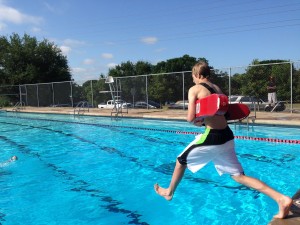Bicycle Safety for the Summer Months, Part II
In part one, we discussed the importance of a properly-fitted helmet. The helmet is, of course, the most significant safety precaution when it comes to head injuries. However, there are additional dangers that bicycling poses besides head injuries. Below you will find further considerations and safety measures that will ensure your child’s summer of biking will not come to a screeching halt due to a spill or accident.
First things first. While babies may smile sweetly in the carrier while mom or dad pedals, parents should think twice before putting any child under 18 months on the back of a bike. The carriers and helmet do protect tiny riders’ heads and extremities, but the real issue is the lack of muscle strength that babies have before the age of two. Even in a carrier, sudden stops, accelerations, and turns can cause the baby’s head to jostle abruptly. Because the neck muscles are not strong enough yet, the head has a tendency to lob, sometimes severely during a bike ride. It’s best to wait until toddlers’ neck muscles are strong enough to withstand any jostling or abrupt motion.
Size matters
Parents may enjoy surprising their little one with a new, shiny bike with all the literal bells and whistles—who can resist that look of shock and awe? However, more important than the surprise factor is the need for children to test out the bike for proper size. For this reason, it’s important that your child do a “test ride” before taking the bike home. The best rule of thumb is that the child, while sitting on the bicycle seat, should be able to reach the ground without straining too much with their tippy toes. Especially for new riders, the ability to put their feet securely on the ground when stopping and to maintain balance means that the bike is the appropriate size.
Street smarts
Although we often see signs that encourage everyone to “share the road,” accidents happen every day. Therefore, to ensure safety and give parents peace of mind while kids bike, it is important that children take initiative to learn the rules of the road and how to best navigate safely.
- Bikes should have plenty of reflectors; however, parents should encourage reflective or bright clothing, headlights on helmets, and any other items that make your child more visible on the road and/or sidewalk. It is important to note that visibility is not only compromised at nighttime. Weather, haze, and even glare from the sun can cause drivers’ views to be obstructed.
- Remind children that wet pavement, even if it’s not currently raining, damp surfaces and puddles can cause brakes to be less effective and tires to skid. They should use extra caution when biking during or after any precipitation.
- Even with the “share the road” signs, insist that children stop at intersections, regardless of a lack of traffic. They should also get into the habit of walking their bikes across crosswalks and looking both ways before crossing, even if they have a walk sign. It is important to talk about how drivers make mistakes on the road. Even if the light is red, children need to make sure that they are looking out for themselves in case a driver is distracted or reckless.
- Sidewalks and bike paths are best options, but if your child is old enough to ride on the road, be sure that he knows that he must ride with traffic—not against it. They should always stay as far to the right side of the road as possible and alert drivers of any intent to turn by using the appropriate hand signals.
- Finally, insist on a “no phone use” rule while riding. The phone, while beneficial to have in an emergency, could pose as a huge distraction to bikers. Remind your child that vigilance is the best safety measure when biking in order to keep the fun rolling!













